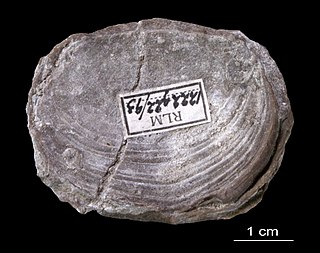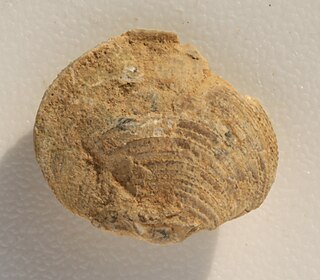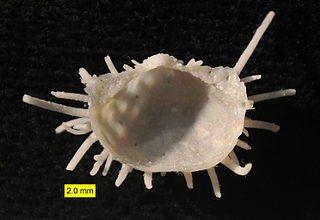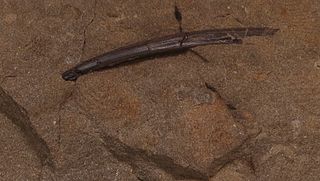Related Research Articles

Palencia is a province of northern Spain, in the northern part of the autonomous community of Castile and León in the north of the Iberian Peninsula. It is bordered by the provinces of León, Cantabria, Burgos, and Valladolid.
Dicoelosia is an extinct genus of brachiopod that lived from the Late Ordovician to the Early Devonian in Asia, Australia, Europe, North America, and South America.

Atrypa is a genus of brachiopod with shells round to short egg-shaped, covered with many fine radial ridges, that split further out and growth lines perpendicular to the costae and 2-3 times wider spaced. The pedunculate valve is a little convex, but tends to level out or even become slightly concave toward the anterior margin. The brachial valve is highly convex. There is no interarea in either valve. Atrypa was a cosmopolitan and occurred from the late Lower Silurian (Telychian) to the early Upper Devonian (Frasnian). Other sources expand the range from the Late Ordovician to Carboniferous, approximately from 449 to 336 Ma. A proposed new species, A. harrisi, was found in the trilobite-rich Floresta Formation in Boyacá, Colombia.
Camarotoechia is an extinct genus of brachiopods found in Paleozoic strata.
Productus subaculeatus is an extinct species of brachiopods. Its fossils are present in the Devonian.

Trimerellida is an extinct order of craniate brachiopods, containing the superfamily Trimerelloidea and the families Adensuidae, Trimerellidae, and Ussuniidae. Trimerellidae is a small but widespread family of warm-water brachiopods ranging from the mid Ordovician (Llandeilo) to late Silurian (Ludlow). Adensuidae and Ussuniidae are monogeneric families restricted to the mid to late Ordovician of Kazakhstan.

Paraspirifer is a genus of large brachiopods that lived during the late Lower and Middle Devonian in what now are Germany, Spain, Morocco and the United States.
Spathognathodontidae is an extinct conodont family ranging from the Silurian to the Devonian.

Cleiothyridina is an extinct genus of brachiopods.
Craniops is an extinct genus of brachiopods in the family Craniopsidae with species known from the Ordovocian to the Devonian.
Caliapora is an extinct genus of corals from the Devonian.
Zychaspis is an extinct genus of Devonian jawless fishes. Species are from the Devonian of Ukraine.

Productida is an extinct order of brachiopods in the extinct class Strophomenata. Members of Productida first appeared during the Silurian. They represented the most abundant group of brachiopods during the Permian period, accounting for 45-70% of all species. The vast majority of species went extinct during the Permian-Triassic extinction event, though a handful survived into the Early Triassic. Many productids are covered in hollow tubular spines, which are characteristic of the group. A number of functions for the spines have been proposed, including as a defensive mechanism against predators.
Plicochonetes is an extinct genus of brachiopods in the extinct family Rugosochonetidae.
Cubanothyris is an extinct genus of prehistoric brachiopods in the extinct family Angustothyrididae. Species are from the Triassic of China, the Russian Federation and Tajikistan. The type species, C. elegans, is found only at River Kuna.

Cosmacanthus is an extinct genus of placoderms in the extinct family Groenlandaspididae that lived during the Late Devonian in Ireland, the UK, Russia and North America. It was named by Louis Agassiz in 1845.
The Arauz Formation is an Emsian fossiliferous stratigraphic unit in Spain. It is a member of the Abadia Group. It is situated in the Province of Palencia, North Spain. It is in the north of Natural Park of Fuentes Carrionas and Fuente Cobre-Montaña Palentina where the Rio Arauz lies. It is from the Devonian of Spain.
Schizophoria is an extinct genus of brachiopod belonging to the superfamily Enteletoidea. Specimens have been found in Devonian through Permian beds in North America, Australia, central and southeast Asia, and eastern Europe.
References
- ↑ Die Oberkoblenzschichten des Bergischen Landes und Sauerlandes. Jb. preuß. geol. L. J Spriestersbach A, 1925
- ↑ Brachiopoda of the suborder Strophomenidina in Czechoslovakia. V Havlíček, 1967
- ↑ Silur und Devon im Arauz-Gebiet (Prov. Palencia, N-Spanien). H. Jahnke, A. Henn, H. Mader and J. Schweineberg, 1983, Newsletters on Stratigraphy, 13(1), pages 40-66, doi : 10.1127/nos/13/1983/40
- H. Jahnke. 1971. Fauna und Alter der Erbslochgrauwacke (Brachiopoden und Trilobiten, Unter-Devon, Rheinisches Schiefergebirge und Harz. Goettinger Arbeiten zur Geologie und Palaeontologie 9:1-105